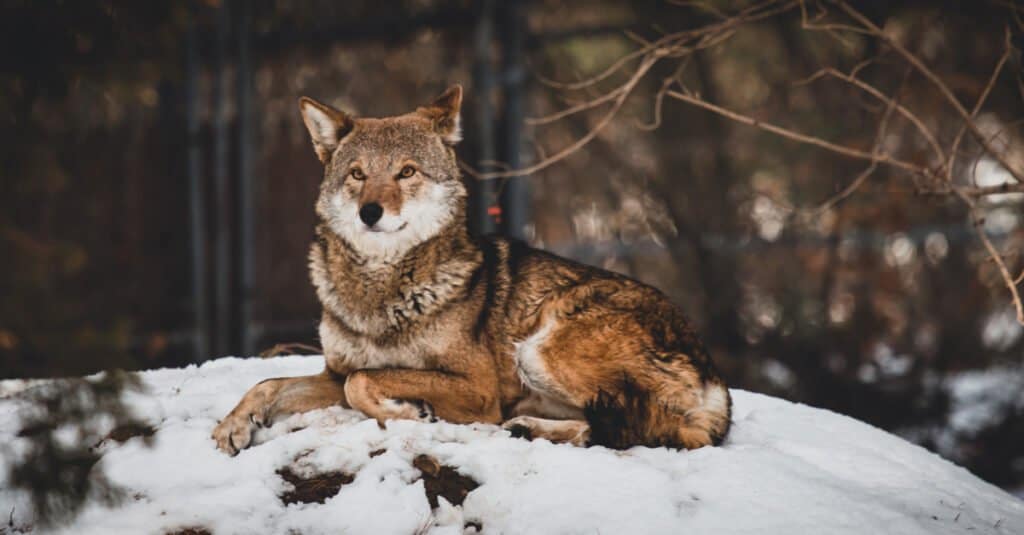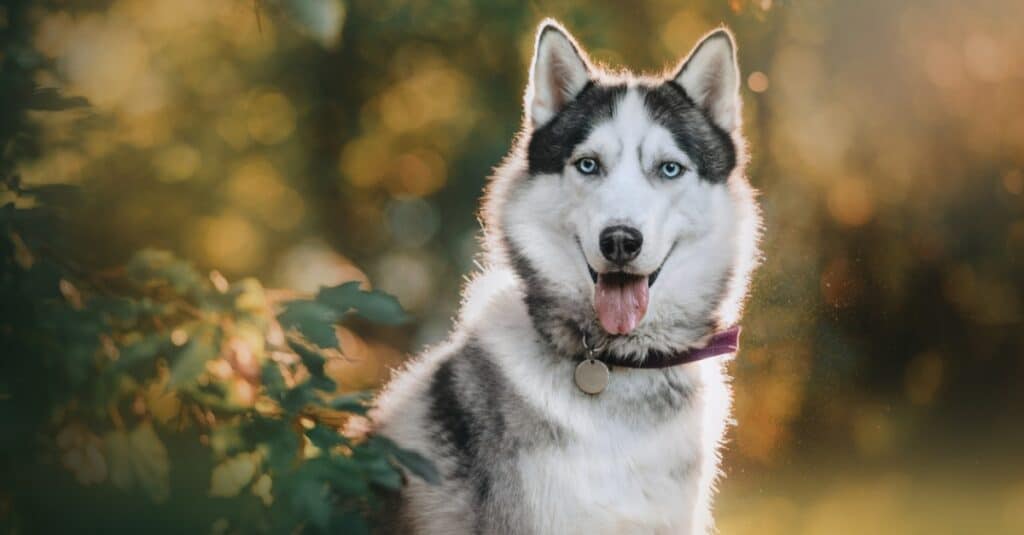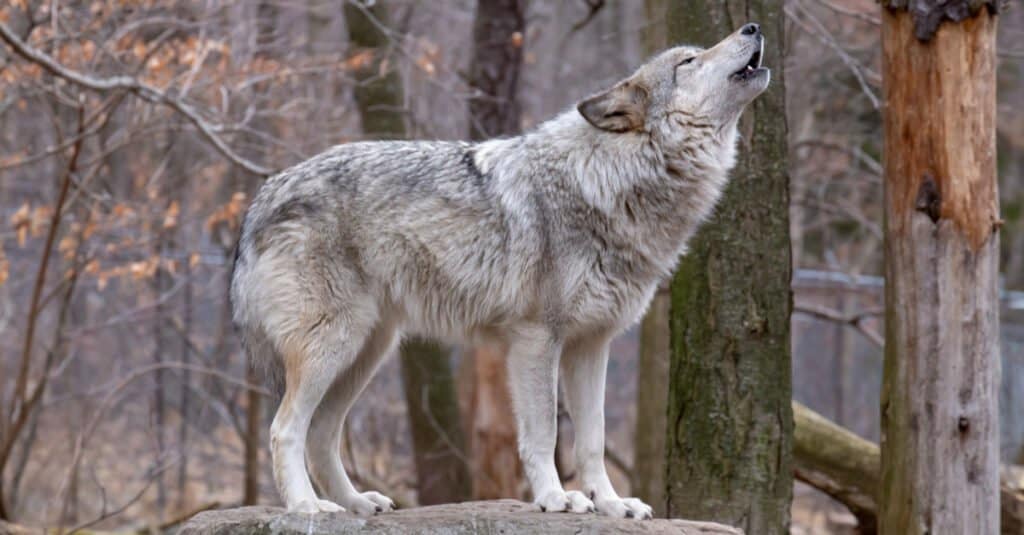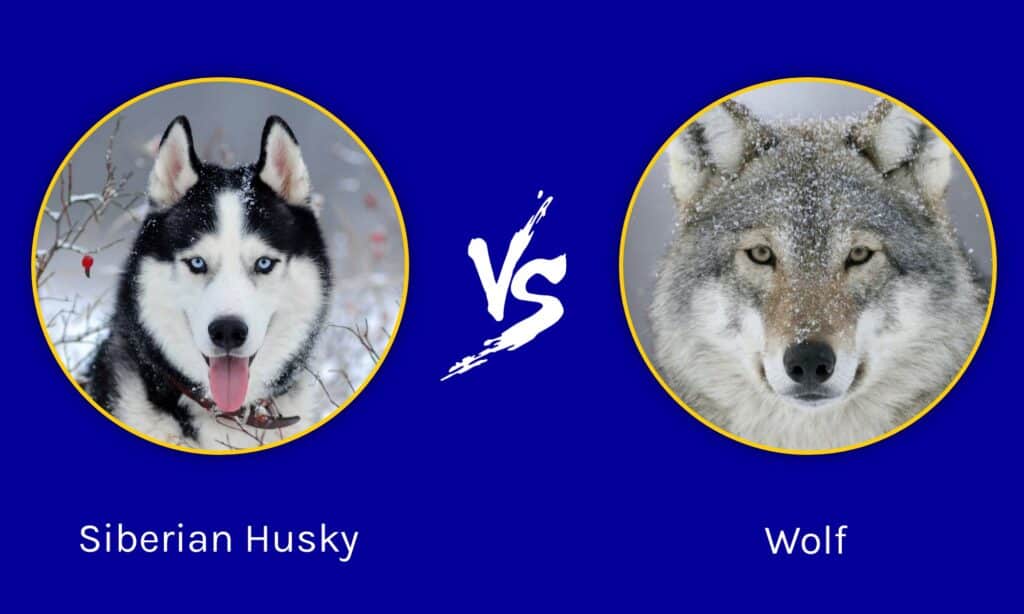What is the difference between a husky vs wolf? Despite their similar appearance, a wide gap separates the domesticated husky from the wild wolf. According to fossil records, humans first domesticated dogs between 20,000 and 40,000 years ago, with the oldest examples of humans being buried with dogs dating back around 15,000 years. While they may share a common ancestor, huskies and wolves represent distinct species. That said, many people often confuse these canines for one another due to their coloring, shape, and “wolfish” appearance. In this article, we’ll discuss 8 key differences separating a husky vs wolf. In addition, we’ll discuss several frequently asked questions concerning huskies and wolves.
Comparing Huskies vs Wolves
The only officially recognized breed of husky is the Siberian Husky. A member of the Spitz genetic family, Siberian Huskies hail from the Arctic tundra in Northeast Asia. Originally, the Chukchi people of Siberia bred Huskies to pull sleds and as companion dogs. That said, several unofficial breeds of husky also exist. While these breeds bear the moniker “husky,” they will not be the focus of our comparison, but we’ll still cover them briefly so as to distinguish them from the Siberian Husky.
Alaskan husky
The Alaskan husky is a mongrel breed that represents a mix of different dogs including English Pointers, German Shepherds, and Salukis. Originally bred as sled racing dogs in Alaska, they lack the typical “wolfish” appearance of other huskies.
Labrador Husky
The Labrador Husky gets its name from the Labrador region of Canada where it originated. For hundreds of years, the Inuit people of the area bred Labrador Huskies as working dogs. Despite its name, the Labrador Husky is not related to a Labrador, but rather to the Canadian Eskimo Dog.
MacKenzie River Husky
The Mackenzie River Husky represents a mix of several different breeds including Saint Bernards and Newfoundlands. Originally from the Yukon Territory of Canada, people bred the MacKenzie River Husky as a powerful sled dog capable of living and working in harsh conditions.
Sakhalin Husky
The Sakhalin Husky is a recently extinct breed native to the island of Sakhalin in Japan. Its name in Japanese, karafuto ken, translates to “Sakhalin dog.” Originally bred as sled dogs, only two purebred Sakhalin Huskies remained in 2011, making the breed functionally extinct.
Meanwhile, the term wolf is used to encompass nearly 40 subspecies. However, several divisions exist within the wolf family. Typically, three classifications emerge that help to distinguish certain wolf populations. These groups include the gray wolf, timber wolf, and red wolf. Of the three, the gray wolf is the most common and refers to any number of subspecies from Eurasia and North America. As such, we’ll be using a typical gray wolf for our comparison, but will briefly cover the timber wolf and red wolf for reference.
Timber Wolf
The timber wolf is not a distinct species, but rather a term used to encompass several subspecies of wolves from North America. Typically, the term is most often associated with the eastern wolf, which also goes by the name timber wolf or the Algonquin wolf. It’s native to the areas around the Great Lakes and southeastern Canada. In addition, the term is sometimes used to refer to the Northern Rocky Mountain wolf and Northwestern wolf (also called the Mackenzie Valley wolf and Alaskan or Canadian timber wolf).
Red Wolf

There has been some debate as to whether the red wolf is a hybrid of wolf and coyote, a subspecies of the gray wolf, or its own distinct species. This has sometimes led to the red wolf being left off of the endangered species list.
©mruizseda/Shutterstock.com
The red wolf is a term used to describe a group of wolves native to the southeastern United States. Similar in appearance to a mix between a coyote and a wolf, the taxonomy of the red wolf is a matter of ongoing debate.
| Husky | Wolf | |
| Habitat and Distribution | Worldwide Originally from the Arctic tundra of Siberia | North America, Eurasia, North Africa |
| Size | 21 to 23.5 inches tall (male) 20 to 22 inches tall (female) 45 to 60 pounds (male) 35 to 50 pounds (female) | 26 to 33 inches tall 85 pounds (European wolf) 79 pounds (North American wolf) Up to 190 pounds |
| Lifespan | 12 to 15 years | 6 to 8 years (wild) Up to 20 years in captivity |
| Coats and Coloring | Double coat, shorter hair Colors include red, black, gray, sable, white, and agouti | Double coat, longer hair Hair is more coarse Tufts of hair on cheeks Typically grayish color |
| Eyes | Brown, blue, or black eyes Almond-shaped Heterochromia common | Yellow, amber, or brown eyes Rounder eyes |
| Body | Shorter muzzle, leaner bodies, ears on top and longer, striped forehead, narrow chest, short legs, smaller head, black or pink nose | Longer muzzle, thicker bodies, ears offset and more triangular, wider chest, longer legs, larger head, black nose |
| Teeth | Shorter | Longer |
| Temperament and Socialization | Domesticated Easily trained Dependent on master Play for fun | Wild Resist training Independent Play to learn hunting skills |
The 8 Key Differences Between Huskies and Wolves

The Siberian Husky is a medium-sized dog with
striking blue
eyes.
©Ksenia Raykova/Shutterstock.com
Husky vs Wolf: Habitat and Distribution
The first difference between a husky vs wolf has to do with their habitat and distribution. As a domesticated breed, huskies can be found worldwide. That said, they adapted to living in cold-weather climates, and do not tolerate heat well. Huskies originate from the Arctic tundra of Siberia, and the breed may be as much as 4,000 years old. Meanwhile, wolves range throughout North America, Eurasia, and parts of Africa. Unlike huskies, some wolves adapted to tolerate warm-weather climates. In these regions, wolves tend to grow shorter, coarser hair, as opposed to the longer hair seen on wolves at higher latitudes.
Husky vs Wolf: Size
The most noticeable difference between a husky vs wolf is their respective size. Nearly every wolf subspecies measures larger than even the largest husky. Typically, male huskies stand 21 to 23.5 inches tall at the shoulder and weigh between 45 to 60 pounds. Female huskies measure slightly smaller, standing 20 to 22 inches tall and weighing 35 to 50 pounds. On the other hand, a wolf can stand anywhere from 26 to 33 inches tall. While Eurasian wolves tend to weigh more than North American wolves, some North American wolf subspecies can grow exceptionally large. European wolves average around 85 pounds, and North American wolves average 79 pounds. That said, records exist of wolves weighing up to 190 pounds.
Husky vs Wolf: Lifespan
On average, huskies tend to live longer than wolves. The average lifespan of a husky is 12 to 15 years. Meanwhile, most wolves only live 6 to 8 years in the wild. Wolves face multiple threats, including from other predators, hunters, disease, cold, and the environment. As a result, the life of a wolf may end up nasty, brutish, and short. However, in captivity wolves can live up to 20 years old, although most don’t live that long.
Husky vs Wolf: Coats and Coloring
Although they both grow double coats, the coat of a husky vs wolf is not the exact same. The hair of a husky is typically shorter than a wolf’s. In addition, huskies come in a wide range of colors, including black, gray, red, white, sable, and agouti. Meanwhile, wolves typically grow longer hair, particularly wolves that live in cold climates. Their hair is coarser than the hair of a husky, which has a fluffier quality. Also, wolves usually grow tufts of hair on their cheeks and thicker hair around their chest and neck. While wolves can come in a range of colors, they typically appear grayish with white and black markings.
Husky vs Wolf: Eyes
It’s difficult to mistake the eyes of a husky for the eyes of a wolf. Husky eyes appear either brown, blue, or black. However, heterochromia is common in huskies, so it’s possible for a husky to have two different colored eyes. Their eyes are almond-shaped, and many owners consider their eyes as one of their most distinctive features. On the other hand, wolves’ eyes generally appear yellow, amber, or brown. Also, their eyes are rounder than husky eyes and generally have a more feral and wild look.
Husky vs Wolf: Body
There exist several slight differences in body composition that can help you differentiate a husky vs wolf. The muzzle of a husky is shorter than a wolf’s, although wolves tend to have a more narrow muzzle. While a husky’s nose can be black or pink, wolf noses are almost always completely black. In addition, a wolf’s head is much larger than a husky’s head and is larger in proportion to its body. Huskies feature a distinctive stripe on their forehead that is absent on the head of wolves. Furthermore, wolves tend to have thicker and longer bodies, wider chests, and longer legs. Finally, a husky’s ears stand upright on top of its head and are quite long, while wolf ears are more offset and triangular.
Husky vs Wolf: Teeth
Due to their shared heritage, huskies and wolves both grow sharp canine teeth designed for ripping and tearing flesh. However, it’s easy to distinguish a husky vs wolf tooth if you look closely. Generally, wolves grow larger, thicker teeth than huskies. While huskies may have grown larger teeth in the past, thousands of years of domestication likely reduced the size of their teeth. Meanwhile, modern wolves require large and strong teeth to kill prey, rip apart flesh, and break bones.
Husky vs Wolf: Temperament and Socialization
While they share some similarities, do not think that means that there is no difference in the temperament of a husky vs wolf. Huskies are domesticated dogs and adapted to companionship with humans. Originally bred as working dogs, huskies readily accept training, and rely on their masters. They will play fight, but their fighting is typically more for fun than as a way to vent their aggression. Meanwhile, wolves are wild animals. They resist training and possess a cold intelligence that is lacking in their domesticated cousins. Wolves crave independence and freedom, and when they play fight it is with the intention to learn essential killing skills, not just for fun.
Frequently Asked Questions Concerning Huskies and Wolves

When a wolf howls, it is simply communicating with members of its pack or competing packs.
©Allison Coffin/Shutterstock.com
Why do huskies and wolves howl?
Wolves howl for several reasons. They may howl to mark their territory or to locate other members of their pack. Although huskies are domesticated, they retain the instinctual urge to howl. They may howl when upset, to communicate with other dogs, or simply to vocalize their feelings.
How many wolves are there?
Reports estimate that there are around 200-250,000 gray wolves worldwide. Most of them reside in Canada, Russia, Alaska, and Central Asia.
How popular are huskies?
The American Kennel Club ranks huskies as the 14th most popular dog breed in America. Since the AKC first recognized the breed in 1930, the husky has continued to climb in popularity.
Husky vs Wolf: Who Would Win in a Fight?

Huskies like the Siberian husky are gentle, non-aggressive dogs in spite of their intimidating appearance. They do have powerful jaws with a bite force of 320 PSI–comparable to pit bulls.
Gray wolves, on the other hand, have a deadly bite force of 400 to 1,000 PSI. And given that these wild animals survive by killing prey as large as moose, elk, and bison, their attack abilities are sharpened. They are also endurance predators–they chase their prey, sometimes for long distances.
In a match-up between these two animals, it’s a safe bet that the predatory wolf would be the victor. No doubt a husky could hold its own valiantly if its life depended on it, but it likely would not have the fight skills to take down a ferocious wolf.
The photo featured at the top of this post is ©
Thank you for reading! Have some feedback for us? Contact the AZ Animals editorial team.







